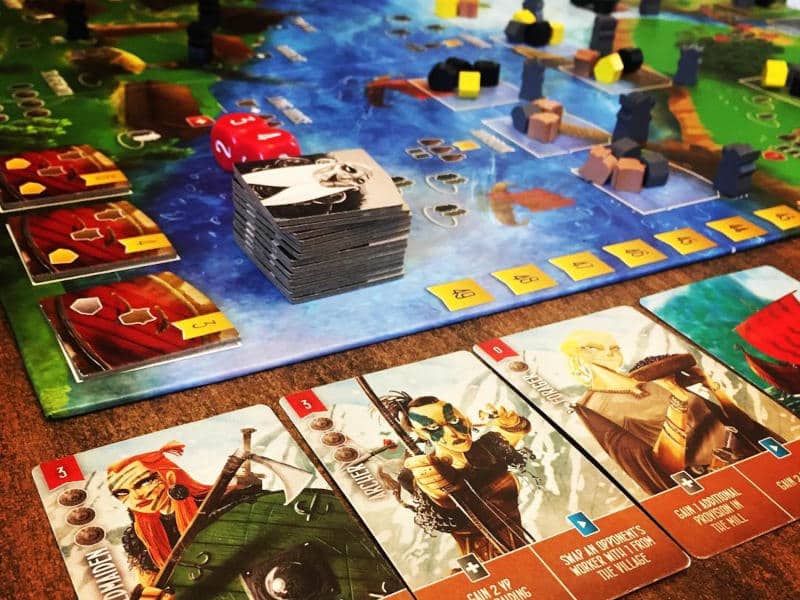The genre of worker placement games is quite large and has evolved a lot over the years. Traditionally, worker placement was all about certain actions being unavailable to other players as soon as someone placed their worker there. At some point, games introduced shared worker place spots. Some games allowed players to kick workers out, returning them to another player who would effectively get another go. In this article, I want to look at the genre and pick out different implementations and variations on the theme.
Listen to the Audio Version
Intro Music: Bomber (Sting) by Riot (https://www.
Music: Bensound
License code: 4Z99RQPZCN8LR59B
Music by Bensound.com
License code: EUUQE9AJCKFYWYYA
All the Workers
Let me start with an angle that not everyone will necessarily have considered: the number of workers in a game. Traditionally, players had a fixed number of workers that they could use. The number of workers used to set the number of turns players had in a round. You would place one of your workers on your turn, carry out the action, then the next player would do the same and so on until nobody had any workers left.
Later on, some games gave players additional workers during the game. Lords of Waterdeep is a classic example, where everyone got an additional worker in the fifth round. From then on, everyone got an extra turn and the game started to speed up.
Other games did something similar or maybe allowed players to take a turn to buy more workers. The choice was between increasing the number of actions you had in future rounds versus doing another important action now before someone else did.
While having more actions available is usually a good thing, having more workers isn’t necessarily an advantage. Uwe Rosenberg‘s Agricola is famous for making players regret that they have extra workers, because they have to feed them all at certain points in the game. So “all your worker are belong to us” isn’t always the best strategy.
Kicking Workers
So instead of giving players more workers, some games introduced the concept of kicking workers out of their spots. If you desperately needed to carry out a certain action, but someone else had already taken it, you could kick their worker out and place yours there instead. The downside was that the worker would go back to the other player who would be able to take an extra turn and therefore carry out an extra action.
Raiders of the North Sea took this concept of kicking out workers to another level. On your turn, you place a worker in an available space, carry out that space’s action, then take a worker back from a different space and carry out its action as well. So you get to take two actions on your turn and you always only have a single worker. It’s a really clever mechanism and I love this game a lot for it. It seems really simple, but creates a lot of interesting interactions between players.
Viticulture solved this problem another way. Instead of kicking out a worker, you can place a special one, the so-called grande worker, on a space that’s already occupied by another worker. That way you wouldn’t give another player an extra turn, but still get to do what you needed to do. Of course, everyone only gets one grande worker to avoid it all getting out of hand.
There is one more variant on the idea of kicking out workers, or rather not kicking them. Instead, different workers can do the same action, but it’s cheaper or gives a bigger benefit for the first worker versus the second or third. Genotype is one example here, but there are many more.

Special Workers
How workers actually function has also changed over time. As mentioned, traditionally each player would have workers for their own exclusive use. However, more recently, the concept of shared workers came about. Raiders of the North Sea does this, in that nobody actually owns any workers. Players just place whichever one they have in their hand and then take a different one back from the board.
I C E implements neutral workers in the form of archaeologists. Players can take them along with an expedition leader meeple that’s exclusive to them, but the archaeologists themselves don’t belong to anyone. My expedition leader can use whatever archaeologists are at my location.
In Hegemony, two players own meeples, but have little say in how they are employed. They get benefits from their meeples, but so do other players. That’s a really interesting way of using workers.
However, the workers in I C E and Hegemony aren’t workers in the traditional sense. You don’t place them on action spaces. The workers are needed to carry out actions, but it is their presence rather than their placement that is important.
Last, but not least, the next evolution in worker placement is the use of dice, instead of meeple. The pip value now forms part of a worker’s function. Some games have added certain requirements to action spaces, forcing players to place dice with certain pip values there before they can carry out the action. My favourite game here is probably Pingyao: First Chinese Banks. You have different types of dice and you roll them at the start of the round, but you can change their pip value in certain ways. It’s a really clever way of introducing some randomness while still allowing for plenty of strategy and tactics.
What Workers Do You Know?
Well, I’m sure there a more ways in which workers are used in games and how they actually work. However, that’s all from me for this article. Now I want to know if you have any experience with worker placement games. Are there any clever twists on this ancient mechanism you can think of? What games do worker placement best in your view? As always, please share your thoughts in the comments below. Let’s work together on compiling a list of interesting worker placement variations.
Keeping the blog running takes time and resources. So if you can chip in, that would be amazing.
Useful Links
- Lords of Waterdeep: https://dnd.
wizards. com/ products/ lords-waterdeep-board-game - Agricola: https://www.
asmodee. co. uk/ collections/ agricola - Raiders of the North Sea review: https://tabletopgamesblog.
com/ 2023/ 05/ 27/ raiders-of-the-north-sea-digital-eyes/ - Viticulture review: https://tabletopgamesblog.
com/ 2020/ 08/ 15/ viticulture-essential-edition-saturday-review/ - Genotype review: https://tabletopgamesblog.
com/ 2021/ 06/ 26/ genotype-a-mendelian-genetics-game-saturday-review/ - I C E: https://thiswayeditions.
com/ ice/ - Hegemony: https://hegemonygame.
com/ - Pingyao: First Chinese Banks review: https://tabletopgamesblog.
com/ 2023/ 01/ 21/ pingyao-first-banks-of-china-saturday-review/
2 Comments
What are you thoughts?
Add your thoughts on the topic to the form below and join the conversation.
Audio Version
Intro Music: Bomber (Sting) by Riot (https://www.
Music: Bensound
License code: 4Z99RQPZCN8LR59B
Music by Bensound.com
License code: EUUQE9AJCKFYWYYA
Playlist
These are the songs I listened to while I was writing this topic discussion article:







Thanks for sharing; worker placement adds a lot of fun options to game design, for sure!
Galactic Cruise, a game coming out on Kickstarter next year from Kinson Key games has a fun take on bumping workers and specialized workers. Whenever a worker is bumped the owner gets an extra bonus, and each player has access to expert workers that when placed, grants an extra bonus on top of the regular placement action.
This article gives a good overview of a few ways that worker placement is used, and I’m sure I’ll reference it when making future designs!
Hello Jared. Thank you for your comments. It’s great to hear that games continue to evolve existing and develop new worker placement mechanisms. The genre is still very much alive. Thank you also for referencing my article. I’m glad it proved useful to you.